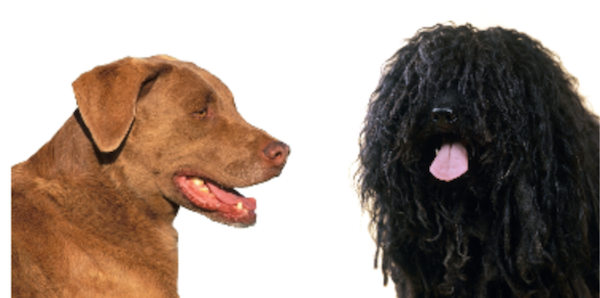
We never failed to be dazzled by the differences in purebred dogs, and how aspects of them seem “tailor made” for their respective jobs. We use two very different breeds to make the point.
Below you can see the photo we took of our very wiggly 8 month old Puli. She is starting to “wool up” very nicely, which is to say that her coat is starting to “fuse” (or mat) at the roots as it forms early cords. Some people call this stage of coat development the unmade bed phase, and it’s about this time that breeders hear from hysterical owners thinking they have to shave their Puli down. As you can see, we gently separated her coat and you can easily see skin:

The Puli is an extremely “elastic” dog capable of mid-air twists, turns, and aerial acrobatics.The legend of Pulik scampering across the backs of sheep to get to the ewe they really want isn’t a myth, we’ve seen it. The breed, however, can work in an environment where winters and summers can be very harsh. The corded coat offers the breed “temperature control” while affording a full range of motion that would be restrictive with any other kind of coat. It also offers a nice bit of predator control; were a wolf or stray dog to bite the Puli, they would get a mouthful of hair for their trouble. Mind you, a working Puli in Hungary does not have the luxurious coat seen in a dog show ring; Shepherds have no compunction about shearing their dog down with the sheep, nor do they worry about the dog chewing off cords that Puli finds troublesome. If the sheep don’t care, they don’t care.
We transition now to the Chesapeake Bay Retriever and ask you to watch the video clip below:
In the scenario above, the dog is actually acting as an ice breaker. Lest you think the dog is a “one off,” we offer another short video below:
How on earth can the dog do that?
The Chessie is a powerful dog driven to retrieve, but for this conversation, we limit ourselves by asking, “How does the dog not get cold?”
The Chesapeake Bay Retriever has a double coat that consists of a short, harsh, wavy outer coat, and a dense fine wooly undercoat that has an abundance of natural oil. The oil essentially allows water to “roll off ” the dog’s back. That, coupled with an effective coat texture, keeps the dog dry which, ideally (in a dog that meets the breed standard), enables a Chessie to swim in cold icy water far longer than most dogs could tolerate.
Unlike the Puli whose skin you can see when the hair is parted, the Chesapeake Bay Retriever’s coat is so wooly, so dense, and so thick that it’s difficult to find skin when the hair is parted. This, in part, is what keeps freezing cold water from reaching the dog’s skin. A harsh coat is layered over the undercoat, and it is this double coat that holds natural oil you can actually feel when running your fingers through it. Bottom line? When a Chessie comes bounding out of the water and shakes as dogs do, he’s barely damp because his short textured coat doesn’t hold water.
Two breeds from opposite sides of the world, each with a “bespoke” coat well suited for the dog’s job. This diversity is what National Purebred Dog Day celebrates.
Image: Chesapeake Bay Retriever by © Rkpimages/Dreamstime.com. Puli from Deposit Photos
